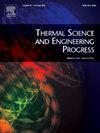Development and characterization of a laboratory scale high flux solar simulator
IF 5.4
3区 工程技术
Q2 ENERGY & FUELS
引用次数: 0
Abstract
In this work, a combined experimental and numerical method is presented for the design and characterization of a high-flux solar simulator consisting of four lamp-reflector units. A direct characterization method is employed, using a heat flux sensor along with ray tracing-based numerical simulation of heat flux map to determine the arc volume geometry and optimum tilt angle for maximum transfer efficiency. The simulated heat flux map agrees reasonably well with the experimental measurements, in terms of peak flux as well as radial distribution. The 10 kW solar simulator achieves a maximum flux of about 1580 kW/ and an average flux of about 630 kW/ on a 70 mm diameter target with the transfer efficiency of 25.4 %. Varied flux levels are achieved by adjusting input power to the lamps and altering the target’s height. The present paper also describes the design and development of an environmental chamber, which serves the dual purpose of thermal management as well as housing for the simulator.
实验室级高通量太阳模拟器的研制与特性研究
本文提出了一种实验与数值相结合的方法来设计和表征由四个灯反射单元组成的高通量太阳模拟器。采用直接表征方法,利用热流密度传感器和基于射线追踪的热流密度图数值模拟来确定弧体几何形状和最佳倾斜角以获得最大的传递效率。模拟的热流密度图在峰值通量和径向分布方面与实验测量结果相当吻合。在直径为70 mm的目标上,10 kW太阳模拟器的最大通量约为1580 kW/m2,平均通量约为630 kW/m2,传递效率为25.4%。不同的通量水平是通过调节输入功率到灯和改变目标的高度。本文还介绍了环境室的设计和开发,该环境室具有热管理和模拟器外壳的双重目的。
本文章由计算机程序翻译,如有差异,请以英文原文为准。
求助全文
约1分钟内获得全文
求助全文
来源期刊

Thermal Science and Engineering Progress
Chemical Engineering-Fluid Flow and Transfer Processes
CiteScore
7.20
自引率
10.40%
发文量
327
审稿时长
41 days
期刊介绍:
Thermal Science and Engineering Progress (TSEP) publishes original, high-quality research articles that span activities ranging from fundamental scientific research and discussion of the more controversial thermodynamic theories, to developments in thermal engineering that are in many instances examples of the way scientists and engineers are addressing the challenges facing a growing population – smart cities and global warming – maximising thermodynamic efficiencies and minimising all heat losses. It is intended that these will be of current relevance and interest to industry, academia and other practitioners. It is evident that many specialised journals in thermal and, to some extent, in fluid disciplines tend to focus on topics that can be classified as fundamental in nature, or are ‘applied’ and near-market. Thermal Science and Engineering Progress will bridge the gap between these two areas, allowing authors to make an easy choice, should they or a journal editor feel that their papers are ‘out of scope’ when considering other journals. The range of topics covered by Thermal Science and Engineering Progress addresses the rapid rate of development being made in thermal transfer processes as they affect traditional fields, and important growth in the topical research areas of aerospace, thermal biological and medical systems, electronics and nano-technologies, renewable energy systems, food production (including agriculture), and the need to minimise man-made thermal impacts on climate change. Review articles on appropriate topics for TSEP are encouraged, although until TSEP is fully established, these will be limited in number. Before submitting such articles, please contact one of the Editors, or a member of the Editorial Advisory Board with an outline of your proposal and your expertise in the area of your review.
 求助内容:
求助内容: 应助结果提醒方式:
应助结果提醒方式:


